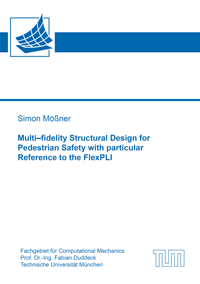
Shop : Details
Shop
Details
45,80 €ISBN 978-3-8440-6701-9Softcover144 pages59 figures212 g21 x 14,8 cmEnglishThesis
May 2019
Simon Mößner
Multi–fidelity Structural Design for Pedestrian Safety with particular Reference to the FlexPLI
Vehicle frontend design for pedestrian safety is a computationally and manually expensive challenge. For impacts of the Flexible Pedestrian Leg Impactor (FlexPLI), this thesis provides a general understanding of the impactor’s kinematics and an efficient approach to optimize its performance for given frontend shapes. Further, based on a given highly resolved finite element model an abstract simplified frontend model with high accuracy is derived. Its generation is simple to automate and it reduces computational cost by 90 %. Especially for structural optimization the efficiency of the model is beneficial. Therefore, three main approaches to parametrize the simplified model are introduced. They focus on three different aspects: The generation of specifications for measures to improve the FlexPLI’s performance, the transferability of the simplification’s observed trends and sensitivities to a full–scale model and the minimization of the computational and manual effort. Limiting factors of the low-fidelity model are investigated as well. In several examples the benefits of the approach are confirmed, especially for early phases of development.
Keywords: multi-fidelity; pedestrian safety; FlexPLI; simplified modeling
Schriftenreihe des Fachgebiets für Computational Mechanics
Edited by Prof. Dr.-Ing. Fabian Duddeck, München
Volume 8
Export of bibliographic data
Shaker Verlag GmbH
Am Langen Graben 15a
52353 Düren
Germany
Am Langen Graben 15a
52353 Düren
Germany
Mon. - Thurs. 8:00 a.m. to 4:00 p.m.
Fri. 8:00 a.m. to 3:00 p.m.
Fri. 8:00 a.m. to 3:00 p.m.
Contact us. We will be happy to help you.



